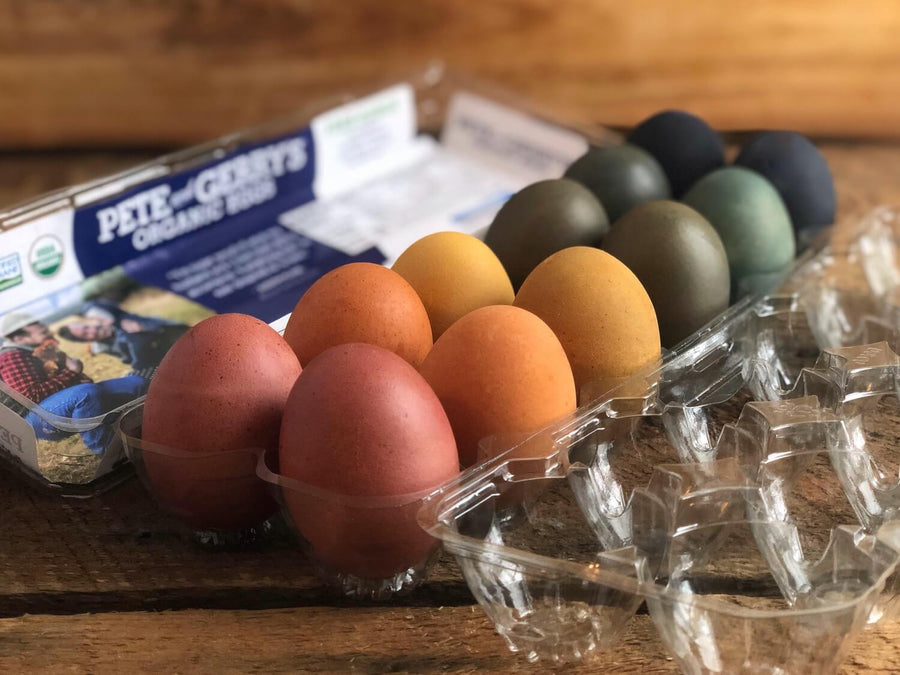
Transform Your Easter Eggs with Nature's Colors
With so many lovely and vibrant colors found in nature, why dye your Easter eggs with anything but beets, onions, cabbage, and berries? Natural egg dyes are like nothing you've ever bought from the store. When used to dye our brown-shelled eggs, they yield deep, earthy tones in just about every color of the rainbow. To transform your Easter eggs into any of these stunning shades, use the following guide to DIY natural egg dyes.
What you'll need to make natural egg dye
Making your own natural egg dye requires just a few ingredients and a couple hours of your time. The first step? Choose your colors and find out which ingredients will yield your desired hues. Then gather your tools and get ready to do some boiling!

Natural egg dye colors and ingredients
- Red or pink: 100% beet juice
- Orange: yellow onion skins
- Yellow: turmeric powder
- Teal: red cabbage
- Chocolate brown: red onion skins
- Violet blue or navy blue: frozen blueberries
- Sparkling grey blue: 100% Concord grape juice
Tools for making natural egg dye
- White vinegar
- Fine strainer and/or cheesecloth
- Reusable containers such as Mason jars (pint-sized work well)
- Medium or large stainless metal pot

How to make natural egg dye
Each of these recipes makes enough dye to color about 2 eggs at a time when using pint-sized Mason jars as dye containers. All recipes can be doubled or even tripled (if using a larger pot) to make larger amounts of dye.
Red or pink egg dye
To make a beautiful shade of pink or rusty red egg dye, look for 100% red beet juice at your local grocery store, avoiding anything with additives. Store juice in the refrigerator until you're ready to use it.
Orange egg dye
To make a subdued shade of orange egg dye that plays beautifully with the natural brown color of our eggshells, place 2 cups yellow onion skins (from about 8 medium onions), 2 cups water, and 1 tablespoon white vinegar in a pot. Bring to a boil, then turn heat down enough to maintain only a slow rolling boil for 30 minutes with the pot covered, keeping the skins fully submerged in the water (if your water level drops below the skins, add just enough hot water to the pot to keep them submerged through the full cook time). Let cool, then strain through a fine strainer (lined with a cheesecloth if available). Store dye in the refrigerator until ready for use. Dye will keep for up to 4 days.
Yellow egg dye
To make a stunning golden yellow egg dye, place 2 tablespoons ground turmeric, 2 cups water, and 1 tablespoon white vinegar in a pot. Bring to a boil, then turn heat down enough to maintain only a slow rolling boil for 30 minutes with the pot covered. If your water level drops to less than 1", add just enough hot water to maintain at least a 1" depth through the full cook time (the fumes from this dye can be strong, so we recommend running your stove fan while it boils). Transfer dye to a heat safe container and let cool on the countertop. Once cool, store in the refrigerator until ready for use (be sure to mix or shake up the dye before using, as turmeric may settle). Dye will keep for up to 7 days.
Teal egg dye
To make an eye-catching blue-green egg dye, place 2 cups chopped red cabbage, 2 cups water, and 1 tablespoon white vinegar in a pot. Bring to a boil, then turn heat down enough to maintain only a slow rolling boil for 30 minutes with the pot covered, keeping the cabbage fully submerged in the water (if your water level drops below the cabbage, add just enough hot water to the pot to keep it submerged through the full cook time). Let cool, then strain through a fine strainer (lined with a cheesecloth if available). Store dye in the refrigerator until ready for use. Please note, although the dye itself will usually have a bright fuchsia color, the eggs themselves will turn out teal. Dye will keep for up to 4 days.
Violet blue or navy blue egg dye
To make varying shades of violet and navy blue egg dye (depending on how long you leave your eggs in this dye), place 16 ounces frozen blueberries, 1 cup water, and 1 tablespoon white vinegar in a pot. Bring to a boil, then turn heat down enough to maintain only a slow rolling boil for 30 minutes with the pot covered, keeping the berries submerged and crushing with a fork as they start to soften (if your water level drops below the berries, add just enough hot water to the pot to keep them submerged through the full cook time). Carefully strain through a fine strainer (lined with a cheesecloth if available). Transfer dye to a heat safe container and let cool on the countertop. Once cool, store in the refrigerator until ready for use. Dye will keep for up to 4 days.
Sparkling grey blue egg dye
To make a cool-toned grey egg dye with a hint of natural shimmer, look for 100% Concord grape juice at your local grocery store, avoiding anything with additives. Store juice in the refrigerator until you're ready to use it.
Chocolate brown egg dye
To make a deep, chocolate brown egg dye, place 2 cups red onion skins (from about 8 medium onions), 2 cups water, and 1 tablespoon white vinegar in a pot. Bring to a boil, then turn heat down enough to maintain only a slow rolling boil for 30 minutes with the pot covered, keeping the skins fully submerged in the water (if your water level drops below the skins, add just enough hot water to the pot to keep them submerged through the full cook time). Let cool, then strain through a fine strainer (lined with a cheesecloth if available). Store dye in the refrigerator until ready for use. Dye will keep for up to 4 days.

How to prepare and dye eggs
Before you let the dye do its work, you'll need to hard-boil your eggs. To do so, we recommend using your Instant Pot or our tried and true steaming method. No matter which method you use, be sure to leave the cooked eggs in an ice bath for at least 15 minutes. This will help the dye adhere to the shells and make them easier to peel if you choose to eat them later.
Tools for egg dyeing
- Pete & Gerry's Eggs, hard-boiled and chilled in an ice bath
- Prepared and chilled natural egg dyes
- Tall, skinny containers (we used wide-mouth pint-sized Mason jars)
- Large slotted spoon
- Paper towels or dish rags
- Wire cooling rack

Instructions for egg dyeing
- Line up your egg dyes on the counter and place a row of paper towels or dish rags underneath them to catch any drips.
- Using a slotted spoon, gently place your desired number of eggs into each dye, ensuring that all eggs are fully submerged.
- Allow the eggs to sit in the dye until the desired depth of color is reached, about 30 minutes to overnight (refer to the list below for recommended times). If keeping any eggs in the dye for more than 2 hours or overnight, store in the refrigerator rather than on the counter.
- When eggs have reached your desired color, use the slotted spoon to remove the eggs from the dye. Gently blot them dry with paper towels, then set on the cooling rack to fully dry.
- To store, place dyed eggs on a plate lined with a paper towel. Eggs should be consumed within 1 week (just be aware that dyes may peel or change color).
Suggested dyeing times:
- Red or pink (beet juice): 1 hour 30 minutes
- Orange (yellow onion skins): 2 hours
- Yellow (turmeric): 1 hour 30 minutes
- Teal (red cabbage): 2 hours (note: this dye tends to change color after drying for a bit)
- Chocolate brown (red onion skins): 2 hours
- Violet blue or navy blue (frozen blueberries): 15-30 minutes for violet blue, overnight for deep navy blue
- Sparkling grey blue (100% grape juice): 1 hour 30 minutes
Tips for getting the best results from your natural egg dyes:
- Peek at your eggs every 30 minutes or so to see how they're progressing in the dye.
- If you start to see bubbling on the surface of your eggs during the dyeing process, this means the acidity of the dye is beginning to eat away at the eggshell. Remove the egg from the dye to keep it from peeling. If dye has already started to peel, you can simply rinse it off and re-dye the egg. This may occur for certain colors, depending on how acidic your particular fruit, vegetables, or juices are.
- If possible, do all your hard-boiling, cooling, and dyeing on the same day for best results. However, the dyes themselves can be made ahead of time.
- Natural dyes can fade fairly quickly, especially on eggs that are kept in the refrigerator. To ensure that they keep their color, we recommend dyeing them on or the day before Easter Sunday.
- If you aren't planning on eating your eggs, you can seal in the color by spraying with a matte or gloss acrylic varnish.
Tag your creations using #peteandgerrys so we can see your work!










